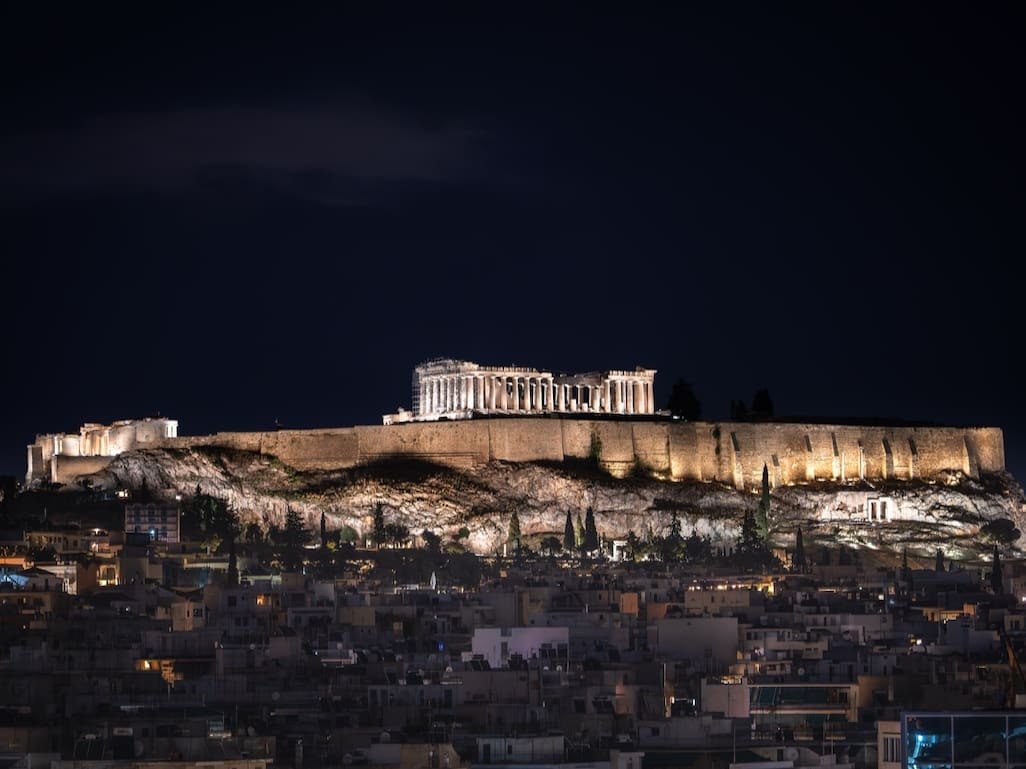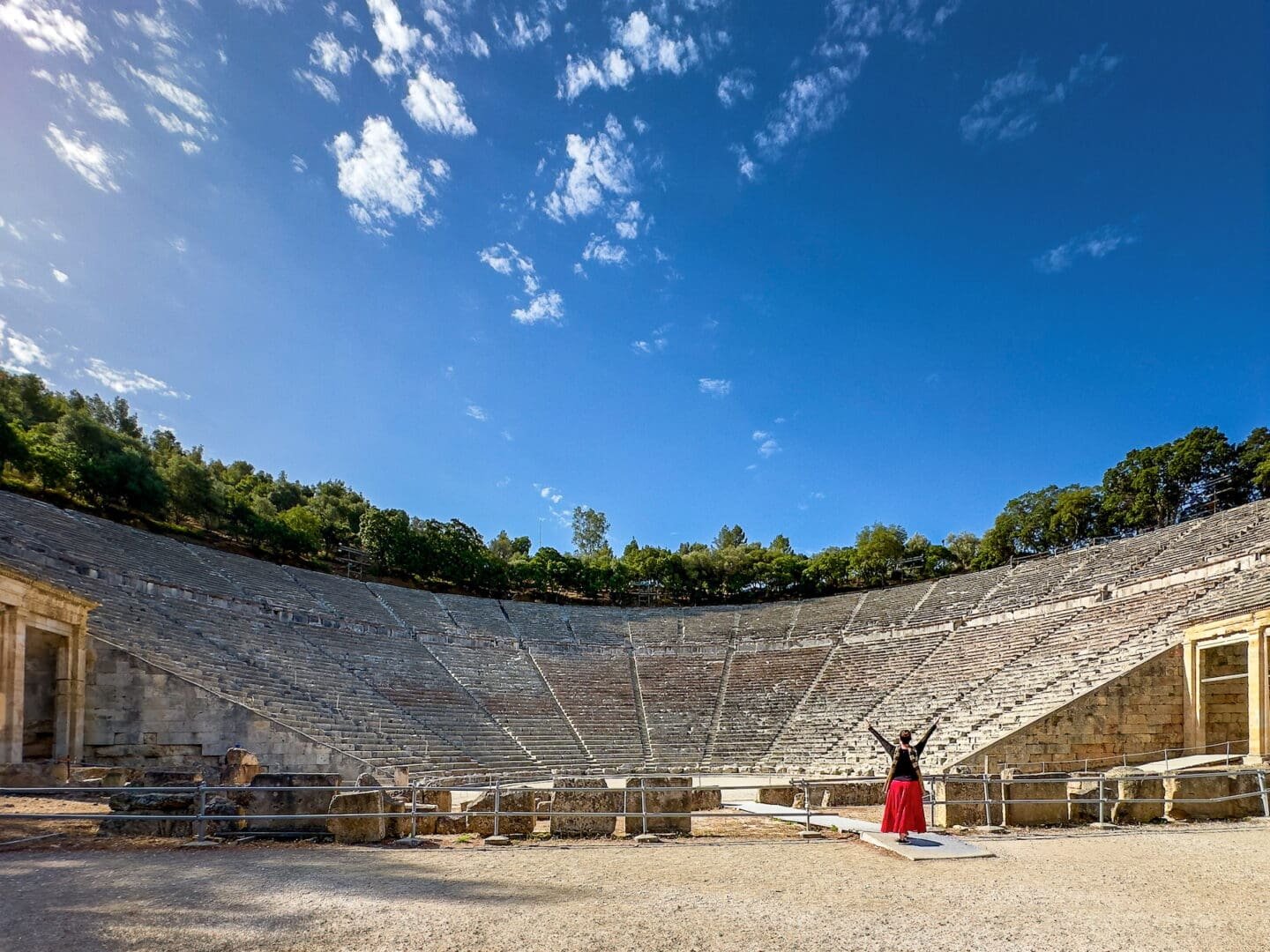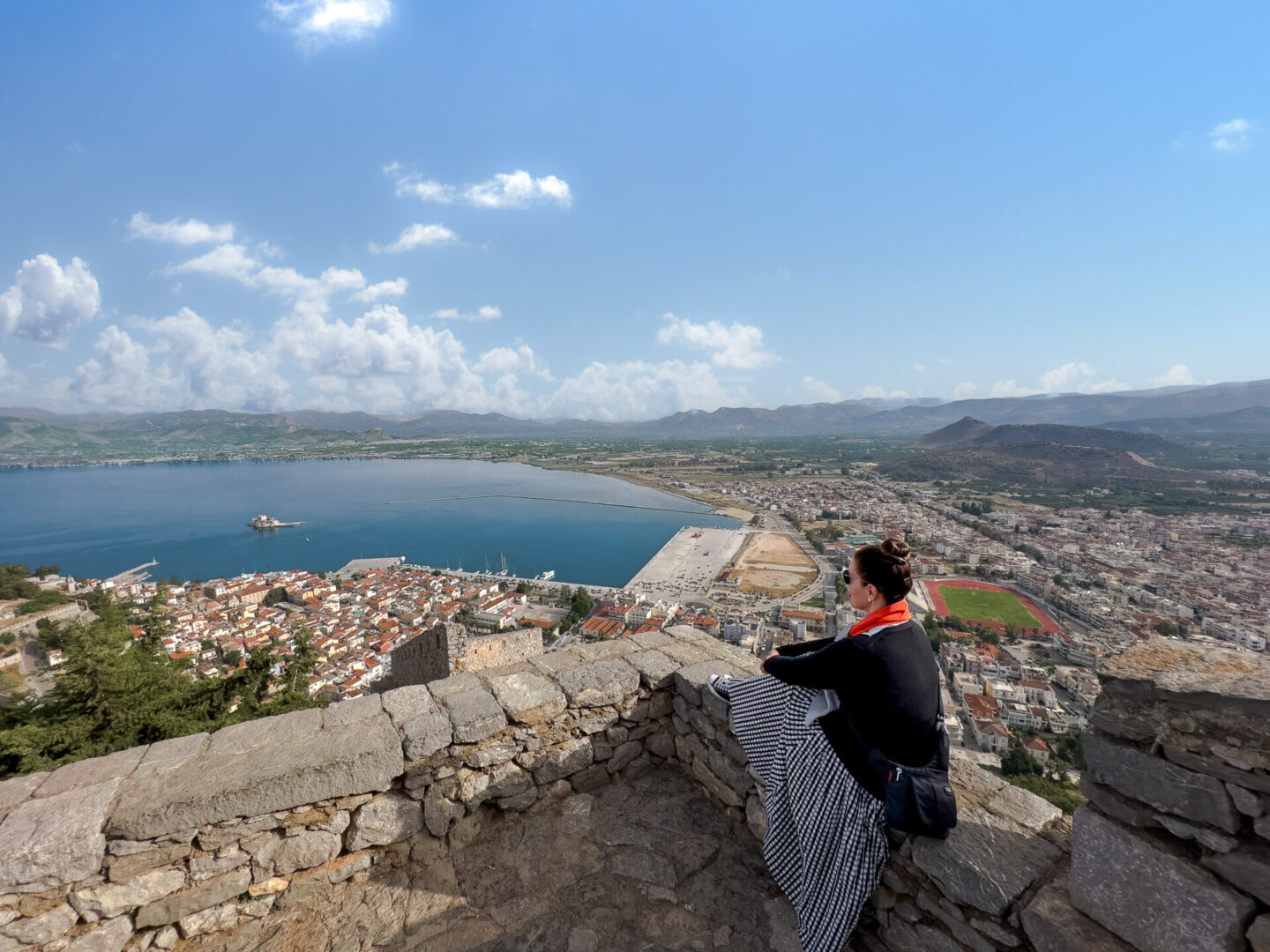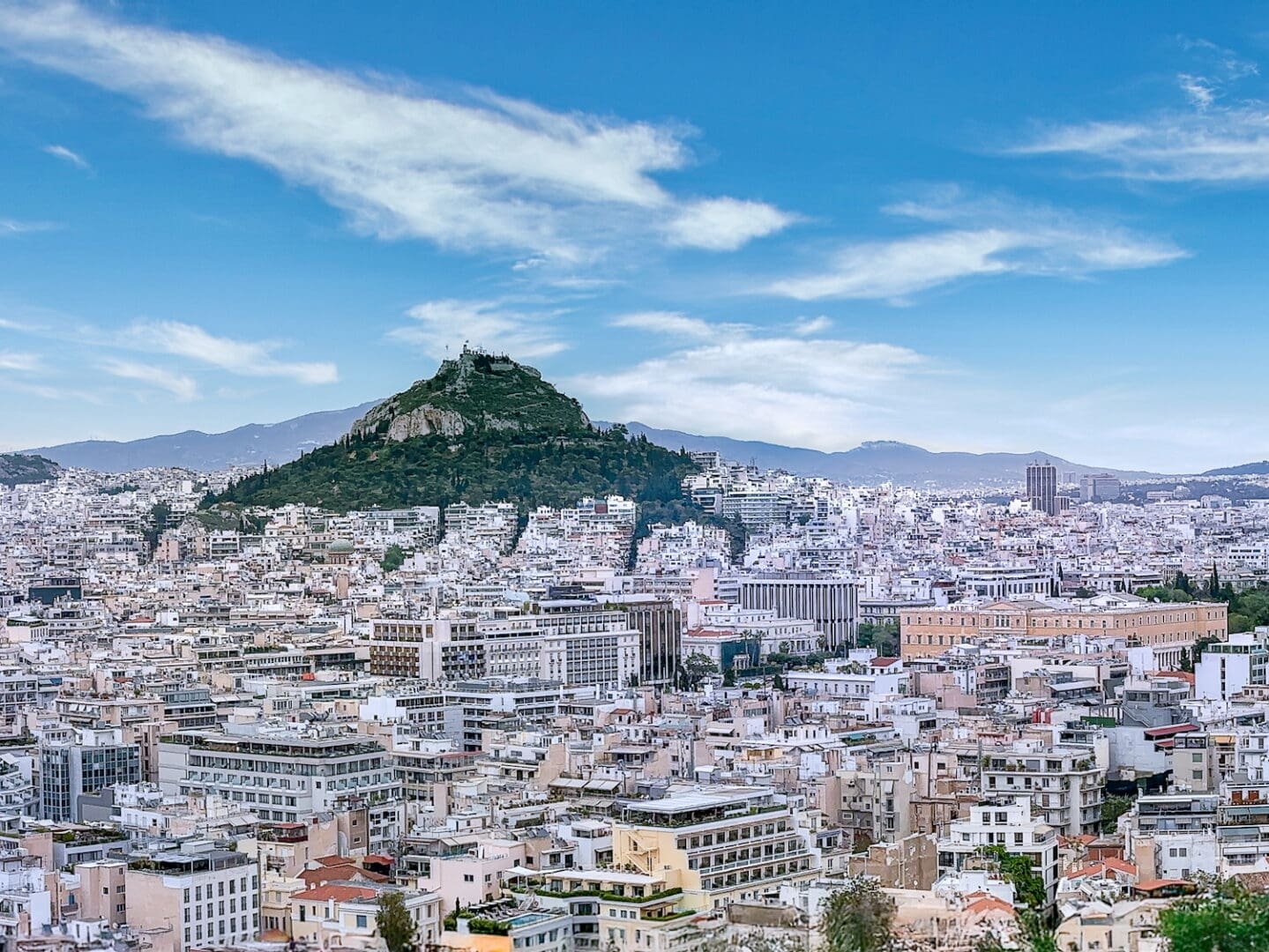
Hidden gems in Athens, Greece, include ancient and modern-day wonders for the traveler who explores on and off the beaten path.
The Greek capital city is truly a treasure trove of monumental proportions, particularly in the historic city center.
Understandably, this monumental treasure comes with a monumental deluge of visitors to the most popular and most famous sights.
Particularly in peak season, the summer months, when max crowds, long queues, and warm temperatures meet.
So, let’s wander together and uncover some hidden gems and special surprises in the historic city center.
It’s a short trip to find a less crowded yet equally delightful attraction just around the corner, down a side street, or a quick ride on the Metro line.
You’ll further find custom interactive maps, travel tips, and candid recommendations from our many years of meaningful travel in Greece.
Ready? Πάμε, let’s go!
- Athens Hidden Gems: A Quick Introduction
- Map of Athens City Center Neighborhoods
- Video: Exploring Hidden Gems in Athens
- Hidden Gems in Athens: Arts and Culture
- Hidden Gems in Athens: Ancient History
- Hidden Gems in Athens: Shopping
- Hidden Gems in Athens: Sacred Places
- Interactive Map of Hidden Gems in Athens, Greece
- Hidden Gems in Athens: Ancient Sources
- Athens Hidden Gems: Modern Resources
- Check Out More Recommendations
- Hidden Gems in Athens, Greece: FAQs
When you book or purchase through some links, Spotlight Sojourns may earn a small commission at no extra cost to you. Thanks for using our affiliate links!
Athens Hidden Gems: A Quick Introduction
Athens is the capital of modern Greece, of course, and also the capital city of Attica, the first of 14 Regions of Greece.
For thousands of years since mythos and antiquity, Athens has continuously inspired imaginations, populations, and transformations.
From the Archaic Greek city clustered around the Acropolis and the Ancient Agora, Athens continued to change during the Classical, Roman, Byzantine, and Ottoman centuries.
In the 19th century, Athens entered the modern era following Greek independence. In 1834, King Otto moved the Greek capital here from Nafplio.
Once again, Athens regained her rightful place among great European cities.
Today, as the nation’s largest city, Athens is home to more than three million residents and counting.
Not to mention tens of millions of visitors per year! Because Athens is one of the Top Ten most visited cities in the world. Likewise, Greece is one of the world’s Top Ten most visited countries.
Yes, Athens and Athens suburbs seem to spread endlessly, rather like the Athenian traffic. Still, the city overall remains walkable and welcoming within her neighborhoods.
Turn off the busiest boulevard, and you’ll find little traditional shops, services, pharmacies, markets, cafes, churches, and schools. In short, local life.
The staggering amount of hidden gems in the sprawling metropolis of Athens is more than this one article could begin to cover.
Given that, please consider the following treasures as inspiration to spark your exploration of Athens hidden gems on and off the beaten track.
All await your discovery within the historic Athens city center. All are within walking distance or easy to reach on Athens public transport.
Map of Athens City Center Neighborhoods
Acropolis (ακρόπολις) means “high city” in Greek, and the high city is the ancient heart of Athens. Since time immemorial, Athens’ vibrant life has always begun in the same place:
Directly below the crown jewels of Greece, landmarks iconic since the 5th century BC Golden Age of Athens.
Athens’ historic city center encompasses several neighborhoods that tourists always love. And where locals still live.
These central neighborhoods begin on the lower slopes of the Acropolis:
Firstly, Plaka (Πλάκα) with its tiny medieval village Anafiotika (Αναφιώτικα).
Secondly, Monastiraki (Μοναστηράκι) is next door to Plaka. Not surprisingly, these two neighborhoods are the most popular areas for first-time visitors to stay.
Thirdly, Syntagma (Σύνταγμα), the 19th-century center of Athens, borders both Plaka and Monastiraki.
Video: Exploring Hidden Gems in Athens
There’s a surprising place in Athens city center that simultaneously bridges Athens’ lively modern city and legendary ancient past.
It’s a special spot where countless residents, commuters, and visitors speed past every day without a second thought. Although some may give the spot a second glance, looking back in curiosity.
This unique intersection of arts and culture perfectly expresses why you want to explore hidden gems in Athens on and off the beaten path.
Hidden Gems in Athens: Arts and Culture
Dromeas, The Runner
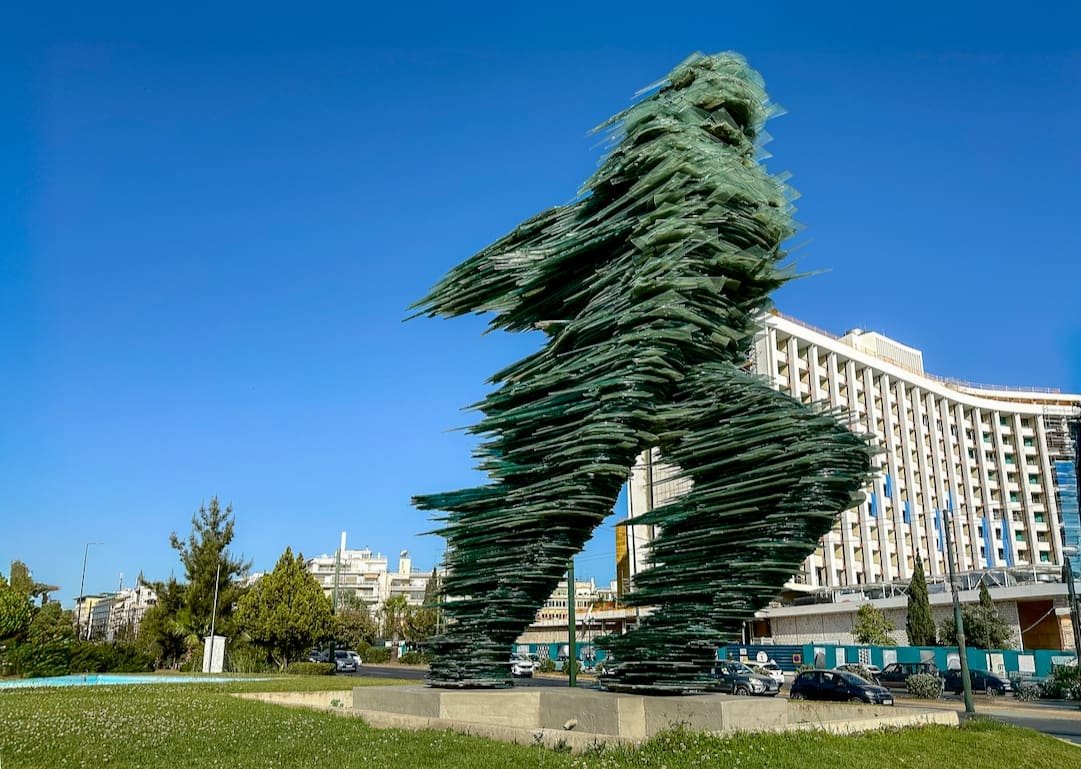
A massive modern glass sculpture rises in the most unexpected location for a masterful artwork:
All of a sudden, Dromeas The Runner appears on a landscaped median between two major thoroughfares, Leoforos Vasileos Konstantinou and Leoforos Vassilissis Sofias.
Across multiple lanes of non-stop traffic stands an equally major construction site. Formerly the Hilton Athens opened in 1963 as the first international hotel brand, the new Ilisian Athens luxury hotel and residences should open in late 2025.
Dromeas The Runner seems to move faster than the cars, taxis, buses, and scooters zooming around his place.
Artist Costas Varotsos spent six years crafting and stacking thousands of glass slabs to complete this masterpiece of motion in 1994.
Address: Dromeas The Runner (Ο Δρομέας) | Megali tou Genous Scholis Square | 10676 Athens Greece
Ancient Olive Tree 1,500 Years Old
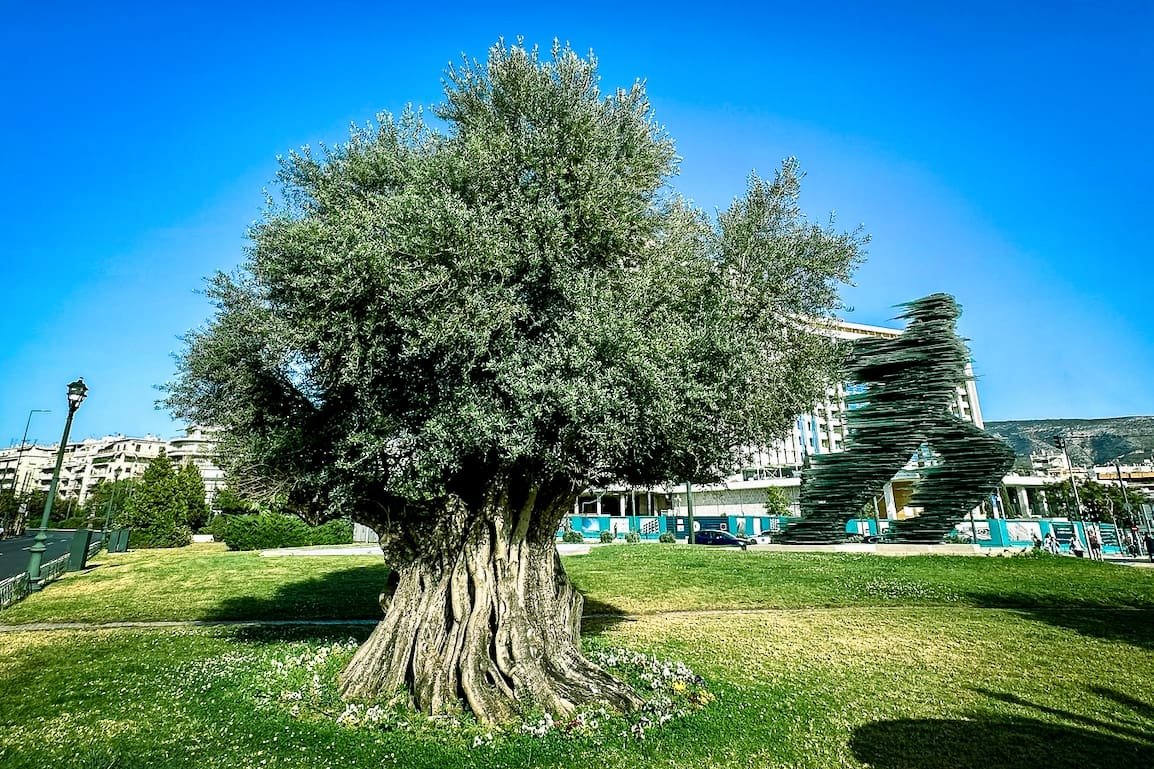
Olive trees in Greece have played a vital role from the very beginning. For example, in legendary tales of Greek mythology, heroic poems of Homer, and origin stories of Athens.
Those ancient stories literally take root in the same landscaped median as Dromeas The Runner. Because mere steps away grows an ancient olive tree first planted about 1,500 years ago.
Only a tiny plaque at the base reveals the tree’s remarkable resilience since the 6th century AD.
Just imagine what this ancient olive tree has witnessed during its long and healthy lifetime!
Address: 1,500-Year-Old Olive Tree | Megali tou Genous Scholis Square | 10676 Athens Greece
Museum of Cycladic Art

Philanthropists Nicholas P. Goulandris and Dolly Goulandris founded the Museum of Cycladic Art with astonishing antiquities from the Greek Islands.
Dating from the Neolithic and Bronze Age, the Cyclades civilization shows striking sophistication and cultural expression in marble, bronze, gold, and pottery.
Thousands of years later, the Cyclades are better known on Instagram for charming blue domes and white houses on islands such as Santorini, Mykonos, Paros, and Naxos.
But whether or not your Greece travel itinerary includes island trips, it’s well worth a short trek off the beaten path in Athens to visit the Museum of Cycladic Art.
The Museum of Cycladic Art offers two venues in proximity, each with a different focus. It’s about a 12-minute to 15-minute walk from Syntagma Square, Athens’ main public square.
Purpose-built and opened in 1986, the Main Building houses the permanent collections of Ancient Greek art and Ancient Cypriot art.
The 19th-century Stathatos Mansion showcases temporary exhibitions of modern Greek and also international artists.
Address: Museum of Cycladic Art (Μουσείο Κυκλαδικής Τέχνης) Main Building | Irodotou 1 | 10674 Athens Greece
Address: Stathatos Mansion (Μέγαρο Σταθάτου) | Neofitou Douka 4 | 10674 Athens Greece
Street Art
Authentic street art isn’t quite as common as the artless graffiti scrawls everywhere in Athens.
But there are indeed specific areas, even in the historic city center, where well-known artists create murals and other street art.
Hip downtown neighborhoods such as Psyri (Ψυρρή) and Gazi (Γκάζι) are trendy areas with a curated street art scene.
Because street art is a dynamic urban art form – constantly changing and evolving – we highly recommend a small walking tour led by a local guide.
Hidden Gems in Athens: Ancient History
Odeon of Herodes Atticus
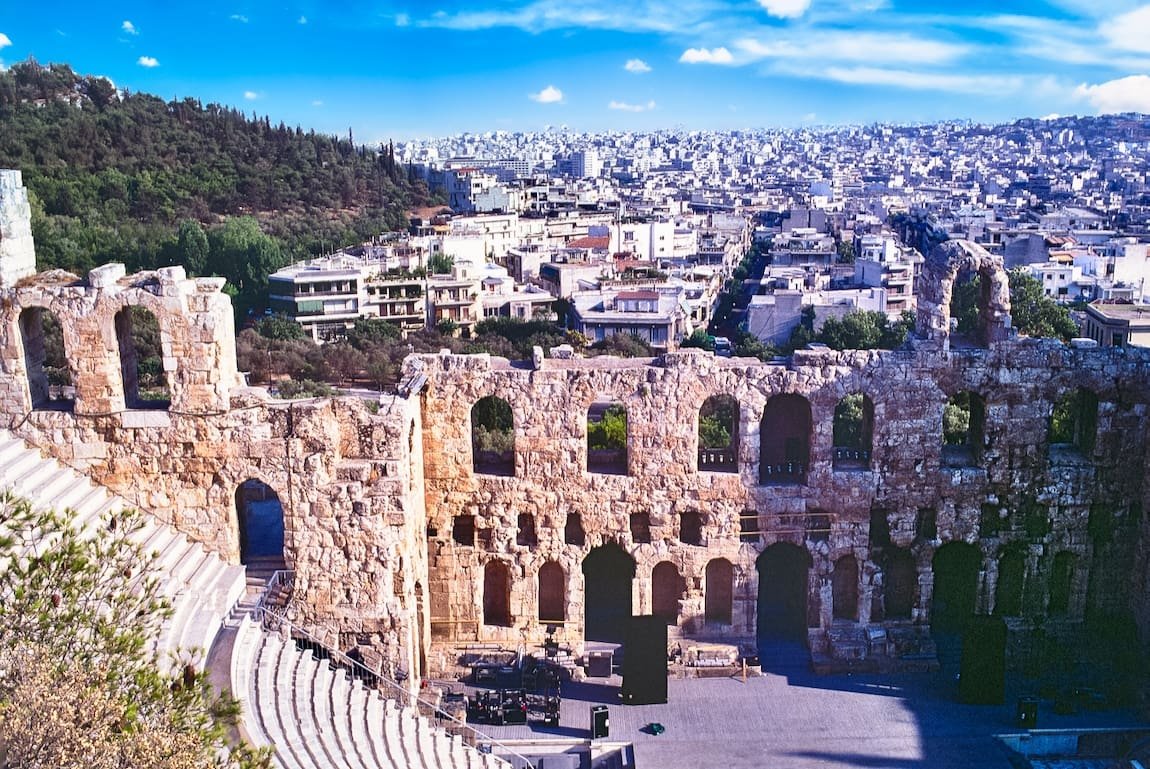
At the foot of the most famous and most visited Greek landmarks – the Acropolis of Athens with the Parthenon – nestles another treasure of ancient Greece.
The Greco-Roman Odeon of Herodes Atticus ascends dramatically on the southwest slope.
Surprisingly to visitors who first catch sight on their climb up to the Plateau, the theatre is separate from the UNESCO World Heritage Site.
Also known as the Herodion, this elegant marble outdoor amphitheater dates from the 2nd century BC.
Abandoned since the 3rd century AD, Herodion’s ancient ruins were restored many centuries later for opera superstar Maria Callas to perform at the 1957 Athens Festival.
As you can imagine, Maria Callas sold out the one-night-only performance in Athens on August 5th, 1957.
Since then, La Divina’s divine legacy lives on at the Odeon of Herodes Atticus. Because every year, the greatest stars of classical music, pop and rock, dance, and theater grace the Herodion stage.
Address: Odeon of Herodes Atticus (Ωδείο Ηρώδου του Αττικού) | Dionysiou Areopagitou | 10555 Athens Greece
Odeon of Herodes Atticus: Travel Tips
The best way – and, in fact, the only way – to go inside the Odeon of Herod Atticus requires a ticket to the Athens Epidaurus Festival. This festival is, quite simply, the highlight of the Athenian cultural season.
With the spectacular stage, excellent acoustics, and stunning views, any event at the Herodion is certain to be unforgettable.
The festival performance season traditionally opens in May and runs through September, weather permitting. Because of the extraordinary setting, tickets typically sell out.
Plan to see a concert, opera, or show under the summer night sky at Athens Epidaurus Festival.
At all other times, you can view the Herodion from the Acropolis path – a popular photo spot. Or at street level along Dionysiou Areopagitou Street.
Roman Agora of Athens and Tower of the Winds
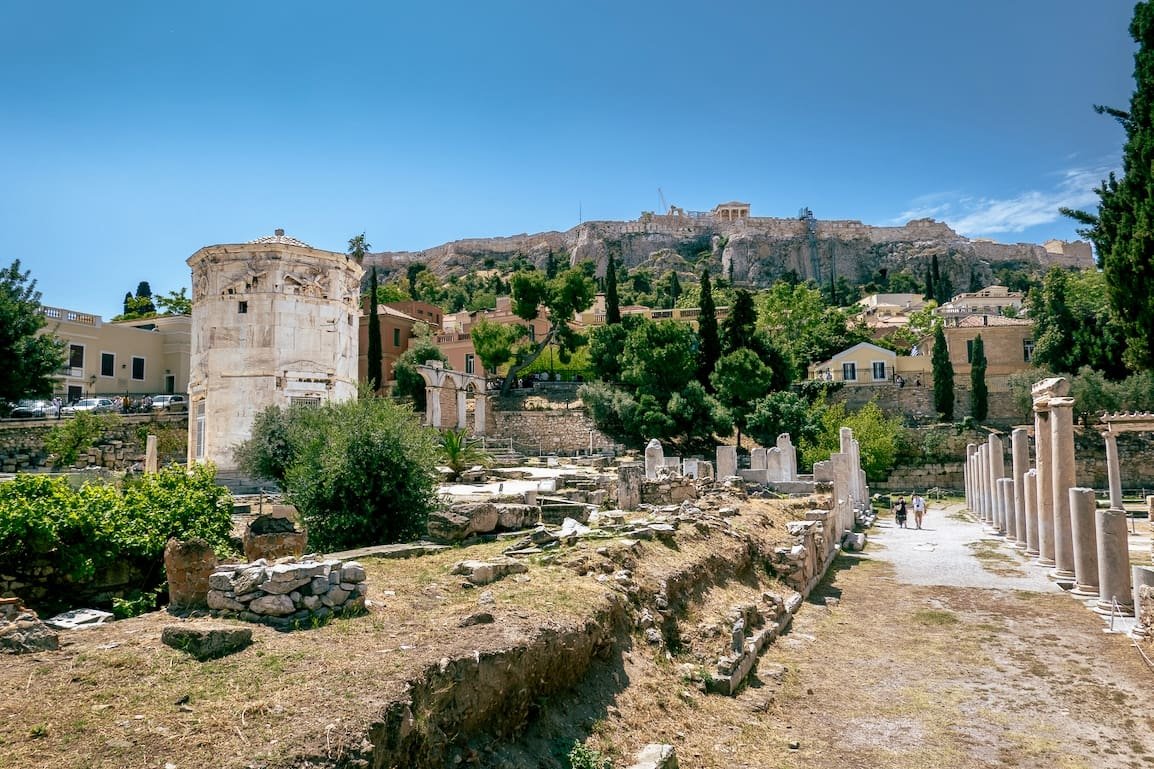
The Roman Agora of Athens is occasionally confused with the well-known Ancient Agora of Athens.
However, the Ancient Greek Agora is much older, dating from the 6th century BC. Whereas this Roman archeological site dates from the late 1st century BC.
Roman Emperors Julius Caesar and Augustus Caesar bequeathed money to build this agora, also called the Roman Forum of Athens.
The complex includes a unique octagonal building: the Tower of the Winds.
The octagonal Tower of the Winds or Horologion is believed to be the world’s oldest weather station.
The elegant marble exterior features sundials, which still tell time today. Each of the eight sides depicts one of the eight Anemoi, the Greek gods of winds.
The interior is one large open room with holes in the floor for the water clock. Water would have flowed from the nearby Roman Aqueduct.
Other meteorological functions likely included an astronomical clock, as well as a weather vane on the roof which is roughly 26 feet (8 m) tall.
Address: Roman Agora of Athens (Ρωμαϊκή Αγορά Αθηνών) and Tower of the Winds (Ωρολόγιο του Κυρρήστου) | Polignotou 3 | 10555 Athens Greece
Roman Agora and Tower of the Winds: Travel Tips
The Roman Agora of Athens opens seasonally. From April 1st to October 31st, the Roman Agora opens daily. From November to March, the Roman Agora opens only on the first Sunday of the month. Weather permitting, of course.
Admission to the Roman Forum includes outside access to the Tower of the Winds.
Individual tickets are available on-site at the Gate of Athena Archegetis, goddess of Colonies.
Convenient combo tickets for the Roman Agora, coupled with the Acropolis, Ancient Agora, Hadrian’s Library, and several other archaeological sites, are additionally available online.
Hidden Gems in Athens: Shopping
Monastiraki Flea Market
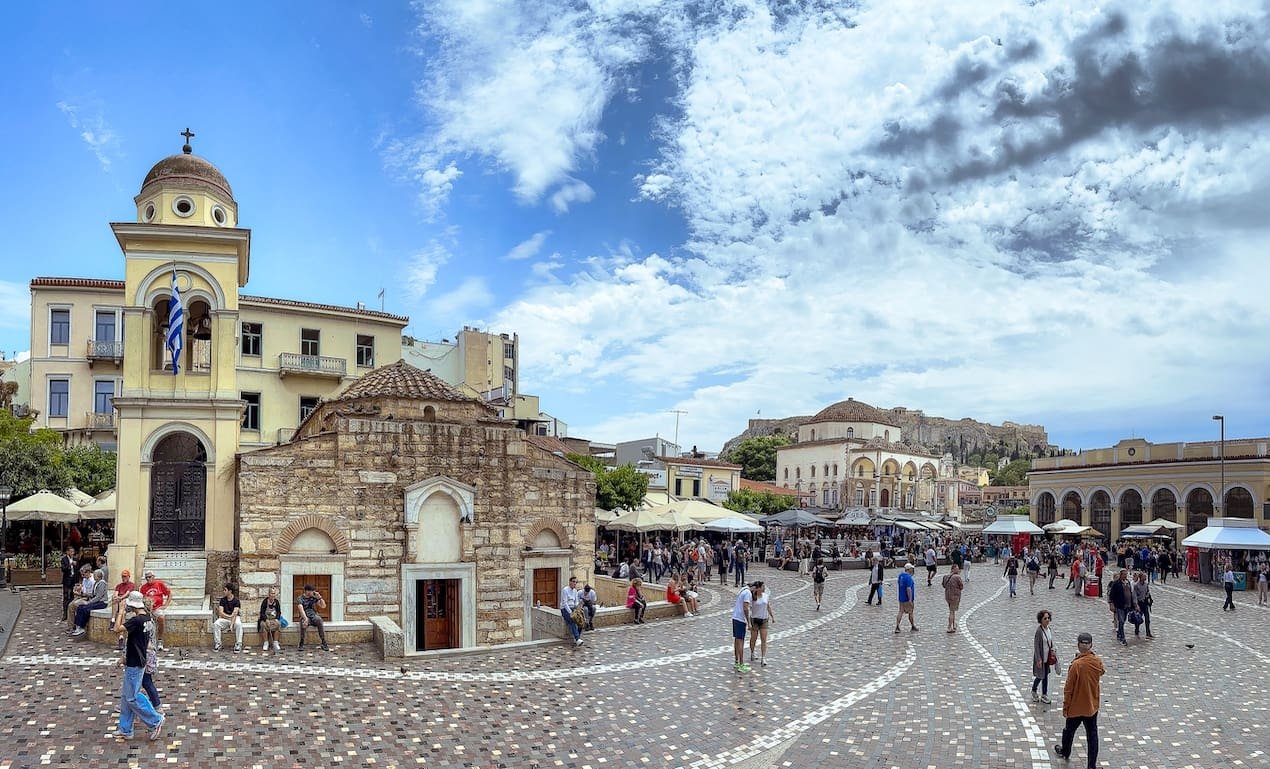
Picturesque Plaka and Monastiraki are colorful and wonderful neighborhoods to wander either on your own or on a guided walking tour.
Historic buildings – neoclassical homes, upscale accommodations, centuries-old churches, and even a former Ottoman-era mosque – fill the cobblestone streets.
Sidewalk vendors, fruit stands, and buskers fill the main squares. Coffee shops, bars, food stalls, and restaurants fill with patrons.
And eclectic shops with fresh, fun, and funky things fill the Monastiraki Flea Market.
The Monastiraki Flea Market, also known as the Athens Flea Market, celebrates independent sellers and intriguing merchandise.
Monastiraki Flea Market itself may be touristy, but there’s forever a hidden gem waiting to be uncovered.
So take time to browse the bookstores, music shops, vintage surplus, and souvenir tchotchkes while you soak in the lively scene.
Address: Monastiraki Flea Market (Υπαίθρια Αγορά Μοναστηρακίου) | Ifestou | 10555 Athens Greece
Ermou Street
Ermou Street (Οδός Ερμού) is Athens’ main shopping boulevard. The street runs approximately one mile (1.5 km) from Syntagma Square, the main plateia or public square, to the Kerameikos Archaeological Site.
This is where Athenians shop, away from the packed shops of Monastiraki Flea Market. However, to clarify, Ermou Street certainly gets packed – especially on weekends and around holidays.
The boulevard offers the usual retail chains and shopping mall brands familiar to shoppers worldwide.
However, as you stroll along, Ermou Street, keep your eyes open while exploring Ermou Street and side streets.
You’ll come across designer concept stores and vintage clothing boutiques. And also Attica City Link, the downtown flagship of this premier Greek department store.
You’ll further discover two small Byzantine churches, one at either end of Ermou Street. Keep reading for more on these ancient churches.
Hidden Gems in Athens: Sacred Places
Byzantine Churches on Ermou Street

Two Byzantine churches begin and end the length of Ermou Street. Both churches date from circa 11th century.
One church is located on the quiet western end of Ermou Street. It’s next to the Kerameikos Archaeological Site, which the travel writer Pausanias visited in the 2nd century AD.
The Holy Church of the Incorporeal Angels, also known as the Archangels, is smaller than its counterpart on the eastern end.
Its Byzantine frescoes are faded, its interior is dark, and its visitors may be few. But still, the little church endures to serve the faithful.
Address: Church of the Incorporeal Archangels (Ιερός Ναός Αγίων Ασωμάτων) | Agios Asomaton 5 | 10553 Athens Greece
Then amidst the busy eastern end of Ermou Street stands the Holy Church of Panagia Kapnikarea.
Rescued in the 19th century and restored in the mid-20th century, Kapnikarea is lovely inside. When sunlight streams in, natural light illuminates restored Byzantine frescoes. As well as newer frescoes painted in the traditional style.
In the 21st century, this active church remains serene inside. Even as shoppers and buskers bustle outside.
Address: Holy Church of Panagia Kapnikarea (Ιερός Πανεπιστημιακός Ναός Εισοδίων της Θεοτόκου or Καπνικαρέα) | Plateia Kapnikareas 3 | 10563 Athens Greece
Petraki Monastery
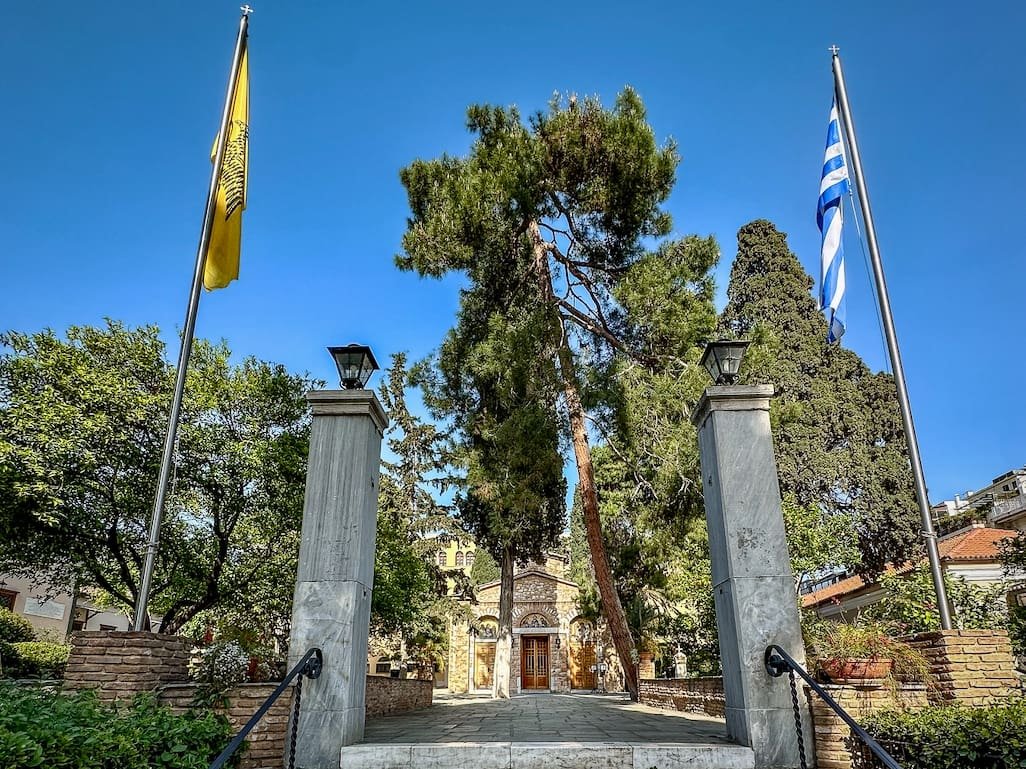
Lush trees towering above an ornate wrought-iron gate beckon the wanderer into a cool green space in Athens city center.
The elaborate gate doesn’t lead into a public park. But rather into the tranquil landscape of an important Byzantine monastery: the Holy Monastery of Asomatoi Petraki.
Petraki Monastery hosts a singular 10th-century church, the seat of the Holy Synod of Greece.
Here you may respectfully enter the oldest church in Athens. The beautiful interior is impeccable, the illuminated frescoes are exquisite.
Like its living monastery, the church actively serves its community with Divine Liturgy daily.
In this sacred setting, the monastic life and liturgical rituals remain unchanged. This is a special and serene refuge for the faithful in the heart of modern Athens.
Address: Petraki Monastery (Ιερά Μονή Ασωμάτων – Πετράκη) | I. Gennadiou 14 | 10676 Athens Greece
Churches and Monasteries: Travel Tips
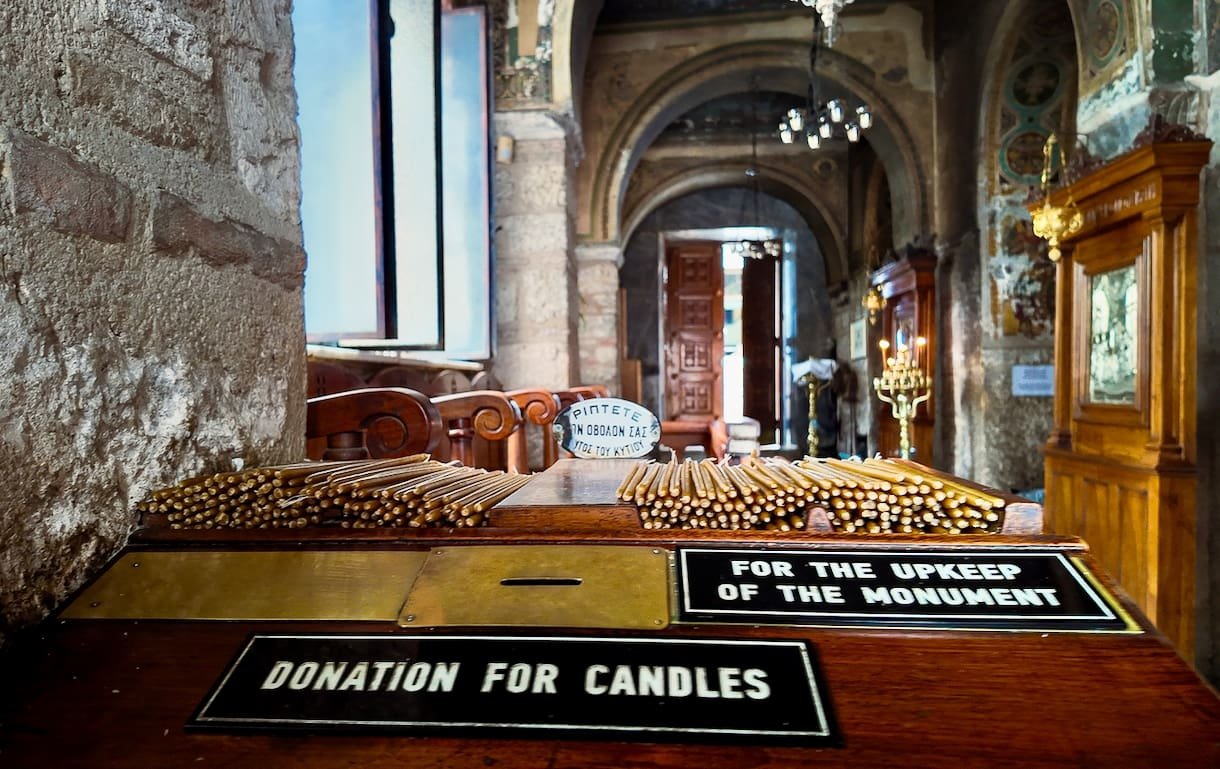
The ancient Orthodox faith remains deeply ingrained and entwined in modern Greek life. Religious holidays, saint name days, and spiritual traditions have remained unchanged for over 2,000 years.
So both a respectful approach and modest attire are appropriate when visiting monasteries and churches in Greece. Further, please note any posts about photography and video.
Basically, it’s expected for everyone – whether attending Greek Orthodox or touring visitors – to cover their legs, arms, and shoulders in the sacred space.
During warm weather, we suggest a lightweight wrap for bare arms, and a long skirt or travel pants to pop over short lengths. These items slip quickly on and off when necessary and then fold easily into a backpack, sling bag, or tote.
Monasteries in Greece rarely charge admission fees except in certain circumstances – for instance, the heavily visited monasteries of Meteora in Thessaly, Greece. Still, it’s a good idea to have a few Euros on hand.
Lastly, if you’d like to light a candle, you’ll find a donation box or tray alongside the candle display.
•••
Interactive Map of Hidden Gems in Athens, Greece
Hidden Gems in Athens: Ancient Sources
Homer, The Iliad. Translated by Emily Wilson, W.W. Norton & Co., 2023.
Homer, The Odyssey. Translated by Emily Wilson, W.W. Norton & Co., 2017.
Pausanias, Guide to Greece Volume 1: Central Greece. Translated by Peter Levi, Penguin Classics, Penguin Publishing Group, 1984.
Pausanias, Guide to Greece Volume 2: Southern Greece. Translated by Peter Levi, Penguin Classics, Penguin Publishing Group, 1984.
Athens Hidden Gems: Modern Resources
Michelin, Streetwise Athens and the Greek Islands Map: Laminated City Center Street Map of Athens, Greece. Michelin Streetwise Maps, 2023.
Rosetta Stone, Greek Language Instruction Software: Learn Unlimited Languages with Lifetime Access. Rosetta Stone, 2019.
Essential Travel Safety Tips, Resources, and Recommendations
Check Out More Recommendations
GET: Now that you’re ready to visit Athens, Greece, get your exclusive free guide to tell your travel stories easily.
•••
Hidden Gems in Athens, Greece: FAQs
Is Athens a walkable city?
Athens overall is a good walkable city, even if certain areas are hilly. Athens’ historic city center is especially walkable, with both major attractions and hidden gems close together in popular areas like Plaka, Anafiotika, Monastiraki, and Syntagma.
Can you find hidden gems in Athens?
Hidden gems in Athens’ historic city center are easy to find, with hidden gems near top tourist attractions. Hidden gems include lesser-known ancient archaeological sites, public art, museums, quaint churches, unique shops, local cafes, and cultural experiences.
Are guided tours a good idea in Athens?
Guided tours in Athens are a good idea. Whether it’s a walking tour of Athens historic city center or a group tour of famous attractions, a professional local guide can deliver expert insight into the rich history, traditional culture, and modern life in Greece.

All opinions expressed are Spotlight Sojourns’ own.
All content and images are original, created with care by yours truly, Marilee Kostadimas and Paul Kostadimas. We’re the Hidden Gemologists® of Spotlight Sojourns: Award-winning travel experts and slow travel storytellers. Because slow travel is meaningful travel, part of a meaningful life. And stories enrich the meaning.

